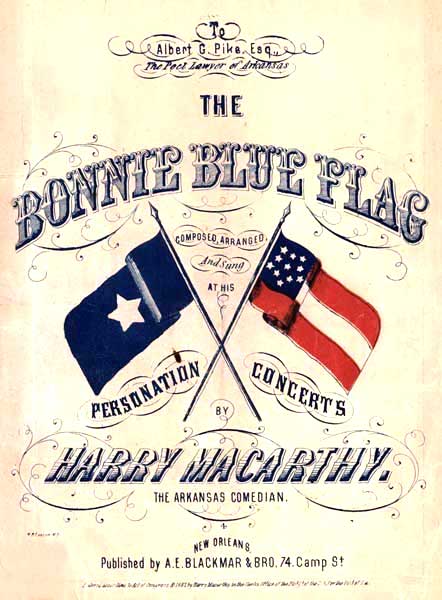We all know about the Southern rebellion we now call the Civil War. And many know and love the Bonnie Blue Flag, cherished as a symbol of the rebellious and freedom-loving spirit that still lives in so many in the South – and yes, other Americans across our land. It is best known as a flag of the Rebels of the Civil War, as we will cover. But the Bonnie Blue’s heritage goes deeper, into an earlier rebellion in a Southern land before it was even part of the United States.
It was September of 1810, and a troop of men about 60 strong rode out in revolt against the Spanish Governor in Baton Rouge. These men were commanded by Philemon Thomas, a veteran of the American Revolutionary War. Thomas had run away from home at the age of 17 to fight for American independence, “…in spite of the fact his father, fearing such a move, had locked up his clothes.”
At Thomas’ side was Major Issac Johnson, whose wife Melissa had made their flag just days before:
“At the head of the column rode a flag-bearer. The banner that waved in the early morning breeze from the staff he carried was a strange one, all blue, like the azure of the sky, in its center a single five-pointed gleaming white star.”
These men lived in West Florida, a strip of land along the coast of the Gulf of Mexico, not very wide north and south, but extending from the Florida panhandle well into Louisiana. A large number of people living in this territory were English speaking folk, despite the fact that West Florida was then owned by Spain.
The rebellion did not spring out of nowhere. These people, used to the traditional rights of British subjects or American citizens, did not take warmly to the authoritarian rule of Spain. And while many wanted to work out their differences with the Spanish rulers, there was another issue.
West Florida had a significant number of inhabitants of French descent. No problem there, but actions were afoot by a few of them to try to bring West Florida under the control of Napoleon Bonaparte. Bonaparte was a malicious dictator who was busy waging war on anyone he could find, having wiped out much of the gains the French had made in their own revolution.
The threat of Napoleonic rule was not going down well with the freedom-loving sons of Britain and America.
Things came to a head when these men discovered that Governor de Lassus had requested additional troops from East Florida. “From now on it was to be war! The sword was to take the place of the crow quill!”
So it was that the now-rebels set out to wrest control of their land. Not two weeks later they captured Baton Rouge and its governor with no loss to themselves. On the 23rd of September, 1810, they raised the Bonnie Blue over the fort they now commanded. Three days later a Declaration of Independence was signed, and the new Republic of West Florida was born.
Meanwhile in Washington, President James Madison had been kept closely informed of what was transpiring. One thing led to another, and 75 days later West Florida was annexed to the United States: the Stars and Stripes was now flying in West Florida. However, the Bonnie Blue was on its way to lasting fame.
Twenty-nine years later the Republic of Texas was in rebellion against Santa Anna of Mexico. The Texans adopted a similar national flag, replacing the white star with a golden one. We know it today as the Burnet Flag, and it is still proudly flown by many. Burnet, the provisional president of Texas, had lived in Louisiana, and certainly knew the legend of the flag of West Florida.
We come now to 9 January 1861 and Mississippi’s secession from the Union. Upon the announcement, a large blue flag bearing a single white star was raised over the capitol building in Jackson. Two days later, in Montgomery, Alabama announced its secession, and Bonnie Blue flags were displayed throughout the city.
One of those who witnessed the raising of the Bonnie Blue in Jackson, Mississippi, was Harry McCarthy. He was so impressed that he wrote a song entitled, “The Bonnie Blue Flag”. It was destined to be one of the most loved songs in the Confederacy, second only in popularity to “Dixie.”
This song spread the lore of the Bonnie Blue far and wide, across the Confederacy and into the hearts of Southerners to this day:
We are a band of brothers
And native to the soil….
The cry rose near and far–
“Hurrah for the Bonnie Blue Flag
That bears a single star!”

